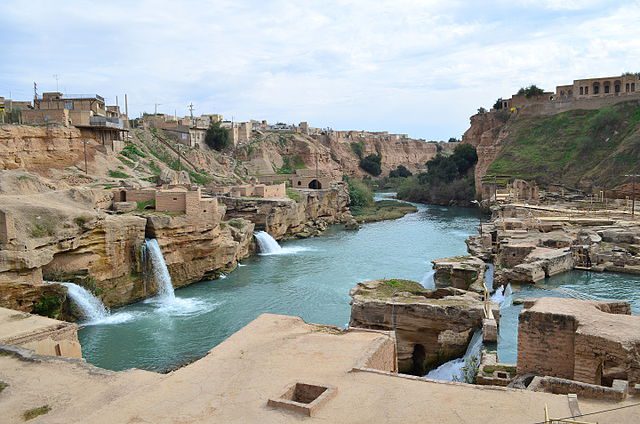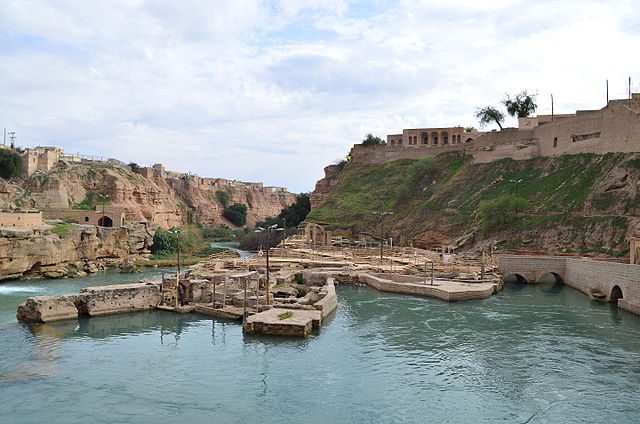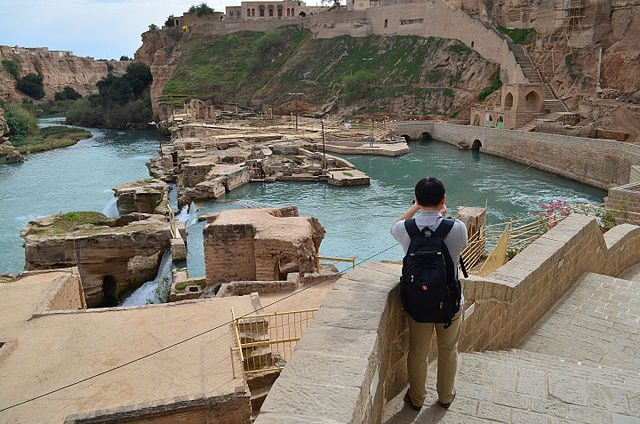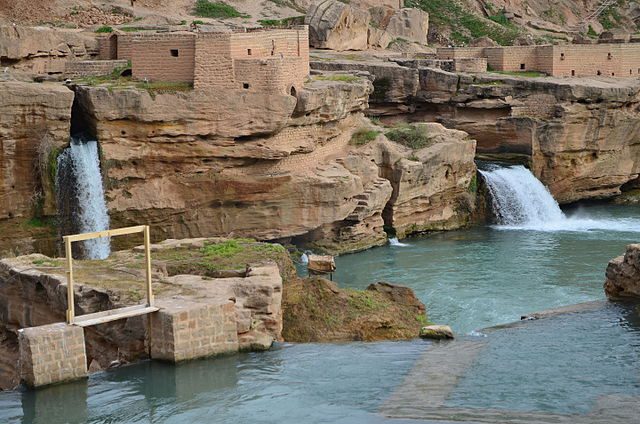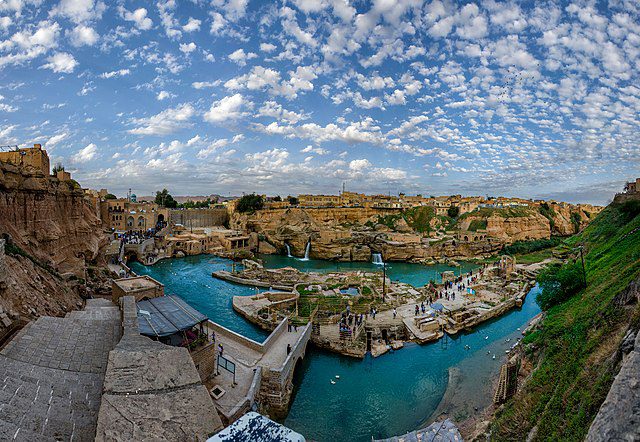Table of Contents
Shushtar, a city in southwestern Iran, is located 90 km north of Ahvaz. In most historical periods from the Sassanid period to the early Pahlavi period, this city was the capital of Khuzestan province. The city of Shushtar owes much of its fame to the ancient water supply system in which it is located. Shushtar historical hydraulic system was inscribed on the UNESCO World Heritage List in 2009 and is considered a creative masterpiece.
This water structure, which is one of the unique works of the Achaemenid period, provides us with good information and statistics from ancient Iran. Also, this work, according to the time of construction and the period in which it was built, is one of the technical and engineering masterpieces in the world.
Shushtar Hydraulic System History
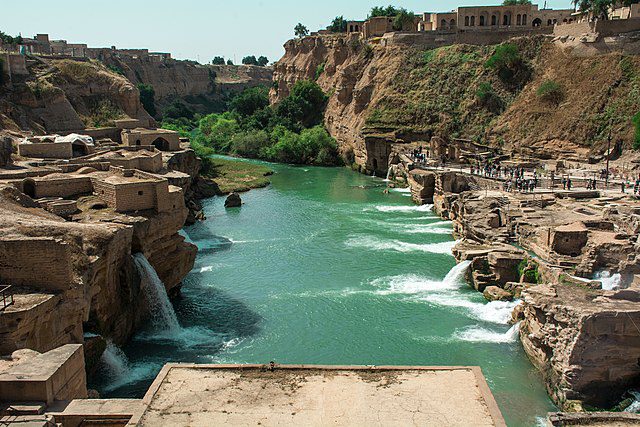
The initial construction of this complex dates back to the fifth century of the Achaemenid period and the reign of Darius the Great, but most of its construction was in the Sassanid period with the aim of optimal use of water and its purification by ancient methods. Shushtar water structures are a collection of bridges, ponds, dams, canals, and tunnels. Even this place is considered the largest industrial complex before the Industrial Revolution.
The oldest artifacts found in this area date back to the Paleolithic and prehistoric times. Due to the Karun River being located next to the city of Shushtar Iran, the ideal location and living conditions were provided in this place and different tribes also wanted to stay in this place. According to the documents obtained, the city of Shushtar was very important during the Elamite period due to its proximity to the Choghaznabil temple.
During the reign of Ardashir I, this city was rebuilt and became an island in the waters, which increased the importance of building a huge complex of water structures in Shushtar. With the construction of this complex, the face of the city was changed, of course, its initial cornerstone was laid by Darius the Great, who achieved significant development during this period.
The city of Shushtar Iran was chosen as the capital of the local rulers of Khuzestan during the Parthian period and was one of the important centers of Khuzestan during the Sassanid period.
This city reached the peak of its fame during the time of Sassanid Shapur and was in its most glorious historical period. Currently, the city of Shushtar is referred to as the Museum of Buildings and Structures, which is why it is described as a unique city in the world.
How Shushtar Historical Hydraulic System Works
Let’s explore some of Shushtar Hydraulic System Facts. Karun is one of the largest and most important rivers in Iran, which before entering Shushtar is divided into two branches called Gargar and Shatit. Gargar is an artificial river that belongs to the time of Ardashir I, the founder of the Sassanid Empire. Three tunnels carry water from the Gargar River to water structures. The incoming water is divided through several channels, turns the mill wheel, and then flows into the pond in the form of a waterfall.
The ancient hydraulic system has an amazing view and is one of the masterpieces of civil engineering in the world. The Sassanids used ancient techniques to share river water between different parts of Shushtar and even some nearby cities, part of which still work centuries later.
The buildings in the ancient site of Shushtar water structures are divided into three parts:
Eastern area: There are about 10 mills in this area. Some of them are the mill of two brothers, Darab Khan, Haj Mendel, Rataq. Each of these mills has two millstones. The water required for these mills is supplied in addition to the entrance tunnel.
Northern area: In this area, in addition to Khodayi mills, Reza Golab or cheese mill, and Rezvan mills, there are facilities related to the Mostofi power plant, which was built in 1332 and a pump house that supplied water to the city.
Western area: There are 21 mills in this area, and the water required for these mills was supplied through a three-furnace tunnel. The way to enter the western area is through a bridge called Duplon. The mills of this area are made in two types of slope and oven models. In addition to the mills, there is an ice factory and a water pump house.
Below the stairs in the western area (this staircase was the way to connect the old part of the city with the western area) and on the roof of the mill called Luali is a building with a square plan and a domed roof in the style of fire temples, which is attributed to the prayer hall. It is located at the end of the area called Sika. The entrance to these chambers is provided by stairs that are built into the rock.
Shushtar mills and waterfalls are some of the most unique examples that have been used for the optimal use of water in ancient times. This area is a complex of dams, tunnels, canals, and watermills, which is an industrial-economic complex and is part of the large complex of water structures in Shushtar, which is frequently mentioned in historical books.
The basis of the complex is that the Gargar Dam blocks the river route and raises the water level to draw water from three tunnels dug in the boulder. The three tunnels direct the water to the complex and are divided into several canals that, after turning the mills, the water flows in waterfalls into pool-like areas.
One of the most prominent features of the complex of mills and waterfalls is its proximity to the historical part of the city of Shushtar. In addition to industrial uses, this area also provided the water needed by the residents on days of water shortage.
A very beautiful and unique visual feature that exists in this collection and gives it a special effect is that the effluent of the mills flows in the form of beautiful artificial waterfalls into the pond-like areas, which creates an eye-catching and pleasant view.
How Shushtar Water Structures Index Works
Shushtar water structures in the UNESCO World Heritage List include several works that we are going to introduce:
1. level dam: As you know, for agriculture, the land must be irrigated with river water, and due to the low level of the river from the land, the water must be raised. Today, water is pumped from the river, but in the past, there was no pump! So they created a structure called a dam, which is built perpendicular to the river and keeps its surface high by blocking the flow of water.
2. Pergola Tower: This tower was built in the Qajar period and is located next to the Shatit River. This place was the place where the Roman emperor or Sassanid Shapur supervised the river and the work of the workers. Of course, some consider it a place to monitor the amount and intensity of river flow.
3. Gargar River: This river was dug in the north of Shushtar city during the Achaemenid period for the development of water structures in the city. Reasons for the construction of this river include reducing the volume of water in the Karun River, irrigating the lands above the Karun River and the security of the city.
4. Gargar Bridge: The history of the construction of this bridge dates back to the Sassanid period and the reason for its construction is to divert the water route from the handmade and historical river Gargar and the water to the windmill tunnels.
5. Waterfalls and water mills: The most significant parts of this complex are located next to the Gargar Bridge and along the Gargar River. There are a large number of windmills in this complex, which is a clear example of using water force to rotate windmills. The complex is divided into three parts: the eastern courtyard, the northern courtyard, and the western courtyard.
Other buildings of this huge complex include the Ayar or Sabi Tower bridge, which is located on the Gargar River and at the bottom of the waterfalls, which was built during the Sassanid period. Shushtar Salasel Castle is also a very large fortress which is located next to the Shatit River and has various sections including several courtyards, barracks, stables, baths, naves, towers, gardens, a tin house, a shrine house, a kitchen, multiple gates. Salasel Castle is the official residence of the governor of Khuzestan and is located on a mountain that is like a small plateau and has been renovated many times.
Shadorvan Bridge is another part of the huge collection of water structures, some of which are called the oldest bridges in the world. The bridge had 44, of which only 16 spans with arches and 8 spans without arches can be seen. Shah Ali Bridge is also left from the Safavid period and is located on Daryoun Creek.
This bridge, which is no longer used after the construction of the new bridge between Ahvaz and Shushtar, had several arches, of which only 3 arches remain today. The Lashkar Bridge, which dates back to the Sassanid period, is located next to one of the six historical gates of Shushtar.
Currently, this bridge is considered to be the healthiest bridge left from the Sassanid period, which is visited by many tourists.
How to Get to Shushtar Historical Hydraulic System
By Car
If you’re up for an adventure by car, just head to 15 Khordad Square on Shushtar’s east side. This bustling spot serves as your guide to the Historical Hydraulic System, making your journey smooth and filled with local charm.
By Bus
For a communal journey, hop on a bus to Shushtar. Get ready to witness the city unfold as you approach the eastern side, with 15 Khordad Square as your landmark. Whether solo in your car or with fellow travelers on the bus, let this square lead you to the wonders of the hydraulic history site.
Recommended Sightseeing Time of Shushtar Historical Hydraulic System
Visit Shushtar between January and March for a pleasant escape from winter’s chill. Shushtar Historical Hydraulic System charms visitors with its historical allure. Situated near Sika along a branch of the Gerger River, these falls blend nature’s beauty with ancient engineering brilliance. Explore the site during these months to enjoy a peaceful encounter with the well-preserved wonders of Shushtar’s hydraulic past.
Working Hours of Shushtar Historical Hydraulic System
Discover the magic of the Shushtar Historical Hydraulic System by planning your visit during its operating hours. In the summer, explore from 8:00 AM to 8:00 PM, and in the winter, from 8:00 AM to 5:30 PM. Immerse yourself in history as you wander through this architectural marvel, where time unfolds within these specified hours, revealing the secrets of ancient engineering.
Where to Eat Near Shushtar Historical Hydraulic System
Abshar Restaurant
Craving Persian delights near? Abshar Restaurant is your go-to. Enjoy authentic dishes that perfectly match the historic vibes of Shushtar, creating a tasty journey through time.
Bernard Restaurant
Seeking a mix of tradition and innovation? Bernard Restaurant blends ancient charm with modern flair. Relish Iranian cuisine in an ambiance that merges Shushtar’s history with culinary creativity.
Pizza Chill
For a different flavor, check out Pizza Chill. This pizzeria brings a fusion of tastes to your table. Take a break from tradition and add a modern twist to your exploration of Shushtar’s historical marvels.
Let your taste buds guide you for an unforgettable dining experience.
Where to Stay Near Shushtar Historical Hydraulic System
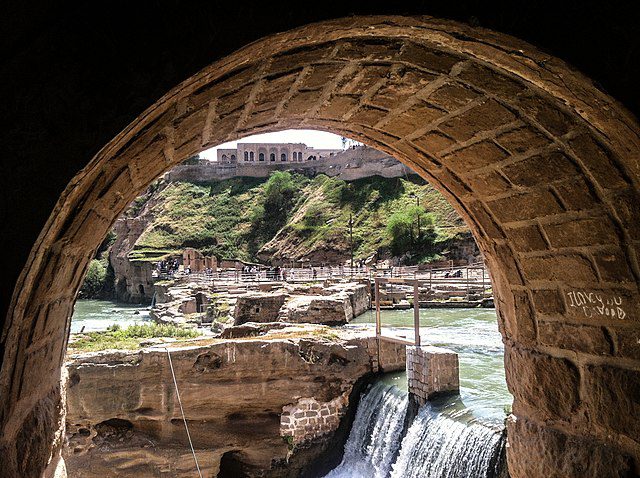
Comfortable Three-Star Options
Finding a good place to stay near Shushtar Historical Hydraulic is exciting in Ahvaz, thanks to a variety of three-star hotels. Choose from Naderi Hotel, Persia Hotel, Oxin Hotel, or Hediye Hotel Apartment, each offering a mix of friendly service and amenities for a pleasant stay.
Luxury Getaway at Pars Ahvaz Hotel
If you’re in the mood for a fancy stay, check out Pars Ahvaz Hotel. It’s a posh place with a classy vibe, providing top-notch service for a memorable experience.
Affordable and Cozy Choices
For those on a budget, you don’t have to compromise on comfort. Iranica Hotel Apartment, Ahvaz Aramesh Guest House, and Ahvaz Iran Hotel are wallet-friendly options that still ensure a comfy stay. With these diverse choices, finding the right place to stay adds to the joy of exploring Shushtar, promising comfort and convenience at every turn.
Other Attractions Near Shushtar Historical Hydraulic
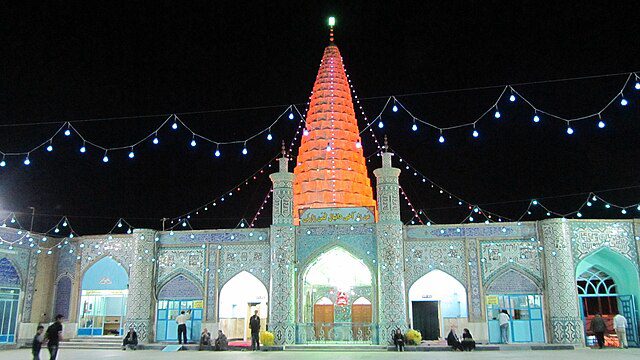
As you explore beyond Shushtar, these awesome places in Khuzestan reveal different sides of the area. Whether it’s the history, nature, or vibrant city life, each stop gives you a unique experience and memories that will stick with you.
Tomb of Daniel
Take a short trip from Shushtar to the Tomb of Daniel, a special place believed to be where the biblical prophet Daniel is buried. The cool architecture and peaceful atmosphere make it a unique spot, letting you feel a strong connection to the area’s interesting history.
Ancient City of Susa
Travel back in time by visiting the Ancient City of Susa, a cool place filled with old stuff from a long time ago. Walk around and check out the old buildings like the Apadana Palace and Acropolis. It’s like a history lesson, but way more exciting.
Shevi Waterfall
Nature lovers will love Shevi Waterfall, a hidden spot in Khuzestan surrounded by greenery. The falling water makes a beautiful scene, creating a quiet place away from the busy city. Whether you want a peaceful break or a nature walk, Shevi Waterfall has something for everyone.
Karun River
Follow the Karun River for a chill time surrounded by nice views. This river goes through pretty landscapes, perfect for relaxing boat rides or walks along the water. The riverbanks are full of plants and animals, making it a calm place to escape from the city buzz.
Abadan
Check out Abadan, a lively city known for its mix of old and new. Famous for its oil stuff, Abadan has a bit of everything – cool markets, tasty local food, and a lively atmosphere. Take a stroll around, try some local snacks, and feel the energy of this busy city – a must-visit during your time in Khuzestan.
FAQs about Shushtar Historical Hydraulic System
Q1: What is the Shushtar historical hydraulic system?
A1: Shushtar’s Historical Hydraulic System is considered a brilliant creation and dates back to Darius the Great in the 5th century B.C. It included making two main canals on the Kârun River. One of these, called the Gargar canal, is still in use today, supplying water to the city of Shushtar.
Q2: Is the Shushtar historical hydraulic system 3000 years old?
A2: The Shushtar Historical Hydraulic System is incredibly valuable on a global scale. It exists in its current form since the 3rd century CE, likely built on foundations from the 5th century BCE or even earlier. It is fully intact, serving various purposes on a large scale, which makes it truly exceptional.
Q3: How does the Shushtar hydraulic system work?
A3: This system operates as follows: initially, the GarGar Dam obstructs the river’s water flow, causing it to accumulate behind the dam. Three tunnels then direct this water into the main complex, dividing it into various channels that set the mills in motion. Subsequently, the water cascades down like a waterfall into a pool.
Q4: What is the elevation of Shushtar?
A4: Situated at an altitude of 21.38 meters (70.14 feet) above sea level, Shushtar experiences a Subtropical Steppe climate.
Q5: How old is Shushtar?
A5: The Shushtar Historical Hydraulic System showcases exceptional universal significance. Its current structure traces back to the 3rd century CE, likely built upon earlier foundations from the 5th century BCE. The system is comprehensive, serving multiple purposes on a grand scale, which sets it apart as truly exceptional.
Last Words: Explore the Best of Shushtar Historical Hydraulic System
Shushtar’s old water system was recognized by UNESCO in 2009 as something really special. It’s a smart creation from a long time ago in Iran. This water system gives us important details about ancient Iran. Also, when it was built and the time it came from, people think it’s one of the best technical and engineering accomplishments worldwide.
To truly immerse yourself in the rich history and culture of Iran, opting for Customised Tours becomes a pivotal choice. Iran Tours and Travel Packages provided by ToIranTour offer a distinctive approach, tailoring each itinerary to cater to the preferences and desires of the traveler. Shushtar, with its intricate water management system dating back to the 5th century, deserves to be explored with attention to detail and a personalized touch.
Let To Iran Tour be your guide in unraveling the mysteries of Iran, ensuring that your visit to the Shushtar Historical Hydraulic System and beyond becomes a cherished memory.

